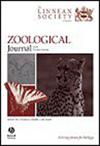南极新种 Orchomenella G.O. Sars, 1890 (Amphipoda: Lysianassoidea: Tryphosidae):相位对比显微层析技术是数字全型的成熟技术吗?
IF 3
2区 生物学
Q1 ZOOLOGY
引用次数: 0
摘要
本文旨在描述南极片脚类动物 Orchomenella Sars,1890 年属的一个新种 Orchomenella rinamontiae sp.nov.,并研究利用同步辐射 X 射线相位对比显微层析成像技术(SR-PhC micro-CT)"原位 "获得的高分辨率表面解剖图像能否取代传统方法来描述一个新种。基于 COI 基因的系统发生学分析支持基于形态学的分类分配。SR-PhC 显微计算机断层扫描对观察三维重建非常有用,它的最大优点是标本可以围绕所有轴线旋转,而且可以通过数字方式去除图像中可能遮挡我们所关注的片脚类动物区域的部分。不过,这还不是全面描述一个新物种的完全可靠的技术。使用光学显微镜和扫描电子显微镜进行经典描述仍然是必要的。不过,SR-PhC 显微计算机断层扫描是一种很有前途的技术,它有可能彻底改变我们研究生物样本的方式,加速生物多样性的研究。本文章由计算机程序翻译,如有差异,请以英文原文为准。
A new Antarctic species of Orchomenella G.O. Sars, 1890 (Amphipoda: Lysianassoidea: Tryphosidae): is phase-contrast micro-tomography a mature technique for digital holotypes?
The purpose of this paper is to describe a new species of Antarctic amphipod of the genus Orchomenella Sars, 1890, Orchomenella rinamontiae sp. nov., and to investigate whether high-resolution images of the surface anatomy obtained ‘in situ’ with synchrotron radiation X-ray phase-contrast micro-tomography (SR-PhC micro-CT) can replace classical approaches to describe a new species. The phylogenetic analyses based on the gene COI support the morphologically based taxonomic assignment. The SR-PhC micro-CT was useful for viewing the three-dimensional reconstructions, with the great advantages that the specimen could be rotated around all axes and that it was possible digitally to remove sections of the image that might have obscured areas of the amphipod on which we were focusing. However, it is not yet a completely reliable technique to describe a new species fully. Classical descriptions using light microscopy and scanning electron microscopy are still necessary. Nevertheless, SR-PhC micro-CT is a promising technique that has the potential to revolutionize the way we study biological samples, accelerating the study of biodiversity.
求助全文
通过发布文献求助,成功后即可免费获取论文全文。
去求助
来源期刊
CiteScore
6.50
自引率
10.70%
发文量
116
审稿时长
6-12 weeks
期刊介绍:
The Zoological Journal of the Linnean Society publishes papers on systematic and evolutionary zoology and comparative, functional and other studies where relevant to these areas. Studies of extinct as well as living animals are included. Reviews are also published; these may be invited by the Editorial Board, but uninvited reviews may also be considered. The Zoological Journal also has a wide circulation amongst zoologists and although narrowly specialized papers are not excluded, potential authors should bear that readership in mind.

 求助内容:
求助内容: 应助结果提醒方式:
应助结果提醒方式:


